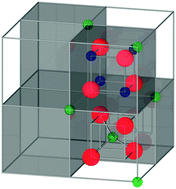Mixing and non-stoichiometry in Fe–Ni–Cr–Zn–O spinel compounds: density functional theory calculations
Abstract
Density functional theory (DFT) calculations have been performed on A2+B23+O42− (where A2+ = Fe, Ni or Zn, and B3+ = Fe or Cr) spinel

* Corresponding authors
a
Materials Science and Technology Division, Los Alamos National Laboratory, Los Alamos, NM 87545, USA
E-mail:
andersson@lanl.gov
Fax: +1 505 667 8021
Tel: +1 505 665 8621
b Materials Science and Technology Division, Los Alamos National Laboratory, Los Alamos, NM 87545, USA
Density functional theory (DFT) calculations have been performed on A2+B23+O42− (where A2+ = Fe, Ni or Zn, and B3+ = Fe or Cr) spinel

 Please wait while we load your content...
Something went wrong. Try again?
Please wait while we load your content...
Something went wrong. Try again?
D. A. Andersson and C. R. Stanek, Phys. Chem. Chem. Phys., 2013, 15, 15550 DOI: 10.1039/C3CP50312G
To request permission to reproduce material from this article, please go to the Copyright Clearance Center request page.
If you are an author contributing to an RSC publication, you do not need to request permission provided correct acknowledgement is given.
If you are the author of this article, you do not need to request permission to reproduce figures and diagrams provided correct acknowledgement is given. If you want to reproduce the whole article in a third-party publication (excluding your thesis/dissertation for which permission is not required) please go to the Copyright Clearance Center request page.
Read more about how to correctly acknowledge RSC content.
 Fetching data from CrossRef.
Fetching data from CrossRef.
This may take some time to load.
Loading related content
